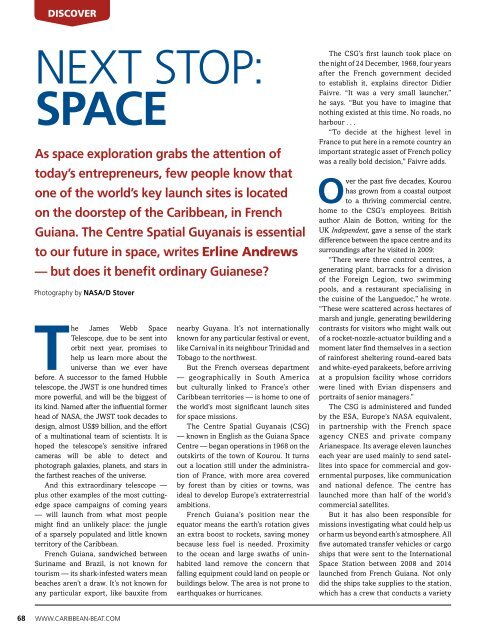You also want an ePaper? Increase the reach of your titles
YUMPU automatically turns print PDFs into web optimized ePapers that Google loves.
DISCOVER<br />
Next stop:<br />
space<br />
As space exploration grabs the attention of<br />
today’s entrepreneurs, few people know that<br />
one of the world’s key launch sites is located<br />
on the doorstep of the <strong>Caribbean</strong>, in French<br />
Guiana. The Centre Spatial Guyanais is essential<br />
to our future in space, writes Erline Andrews<br />
<strong>—</strong> but does it benefit ordinary Guianese?<br />
Photography by NASA/D Stover<br />
The James Webb Space<br />
Telescope, due to be sent into<br />
orbit next year, promises to<br />
help us learn more about the<br />
universe than we ever have<br />
before. A successor to the famed Hubble<br />
telescope, the JWST is one hundred times<br />
more powerful, and will be the biggest of<br />
its kind. Named after the influential former<br />
head of NASA, the JWST took decades to<br />
design, almost US$9 billion, and the effort<br />
of a multinational team of scientists. It is<br />
hoped the telescope’s sensitive infrared<br />
cameras will be able to detect and<br />
photograph galaxies, planets, and stars in<br />
the farthest reaches of the universe.<br />
And this extraordinary telescope <strong>—</strong><br />
plus other examples of the most cuttingedge<br />
space campaigns of coming years<br />
<strong>—</strong> will launch from what most people<br />
might find an unlikely place: the jungle<br />
of a sparsely populated and little known<br />
territory of the <strong>Caribbean</strong>.<br />
French Guiana, sandwiched between<br />
Suriname and Brazil, is not known for<br />
tourism <strong>—</strong> its shark-infested waters mean<br />
beaches aren’t a draw. It’s not known for<br />
any particular export, like bauxite from<br />
nearby Guyana. It’s not internationally<br />
known for any particular festival or event,<br />
like Carnival in its neighbour Trinidad and<br />
Tobago to the northwest.<br />
But the French overseas department<br />
<strong>—</strong> geographically in South America<br />
but culturally linked to France’s other<br />
<strong>Caribbean</strong> territories <strong>—</strong> is home to one of<br />
the world’s most significant launch sites<br />
for space missions.<br />
The Centre Spatial Guyanais (CSG)<br />
<strong>—</strong> known in English as the Guiana Space<br />
Centre <strong>—</strong> began operations in 1968 on the<br />
outskirts of the town of Kourou. It turns<br />
out a location still under the administration<br />
of France, with more area covered<br />
by forest than by cities or towns, was<br />
ideal to develop Europe’s extraterrestrial<br />
ambitions.<br />
French Guiana’s position near the<br />
equator means the earth’s rotation gives<br />
an extra boost to rockets, saving money<br />
because less fuel is needed. Proximity<br />
to the ocean and large swaths of uninhabited<br />
land remove the concern that<br />
falling equipment could land on people or<br />
buildings below. The area is not prone to<br />
earthquakes or hurricanes.<br />
The CSG’s first launch took place on<br />
the night of 24 December, 1968, four years<br />
after the French government decided<br />
to establish it, explains director Didier<br />
Faivre. “It was a very small launcher,”<br />
he says. “But you have to imagine that<br />
nothing existed at this time. No roads, no<br />
harbour . . .<br />
“To decide at the highest level in<br />
France to put here in a remote country an<br />
important strategic asset of French policy<br />
was a really bold decision,” Faivre adds.<br />
Over the past five decades, Kourou<br />
has grown from a coastal outpost<br />
to a thriving commercial centre,<br />
home to the CSG’s employees. British<br />
author Alain de Botton, writing for the<br />
UK Independent, gave a sense of the stark<br />
difference between the space centre and its<br />
surroundings after he visited in 2009:<br />
“There were three control centres, a<br />
generating plant, barracks for a division<br />
of the Foreign Legion, two swimming<br />
pools, and a restaurant specialising in<br />
the cuisine of the Languedoc,” he wrote.<br />
“These were scattered across hectares of<br />
marsh and jungle, generating bewildering<br />
contrasts for visitors who might walk out<br />
of a rocket-nozzle-actuator building and a<br />
moment later find themselves in a section<br />
of rainforest sheltering round-eared bats<br />
and white-eyed parakeets, before arriving<br />
at a propulsion facility whose corridors<br />
were lined with Evian dispensers and<br />
portraits of senior managers.”<br />
The CSG is administered and funded<br />
by the ESA, Europe’s NASA equivalent,<br />
in partnership with the French space<br />
agency CNES and private company<br />
Arianespace. Its average eleven launches<br />
each year are used mainly to send satellites<br />
into space for commercial and governmental<br />
purposes, like communication<br />
and national defence. The centre has<br />
launched more than half of the world’s<br />
commercial satellites.<br />
But it has also been responsible for<br />
missions investigating what could help us<br />
or harm us beyond earth’s atmosphere. All<br />
five automated transfer vehicles or cargo<br />
ships that were sent to the International<br />
Space Station between 2008 and 2014<br />
launched from French Guiana. Not only<br />
did the ships take supplies to the station,<br />
which has a crew that conducts a variety<br />
68 WWW.CARIBBEAN-BEAT.COM


















